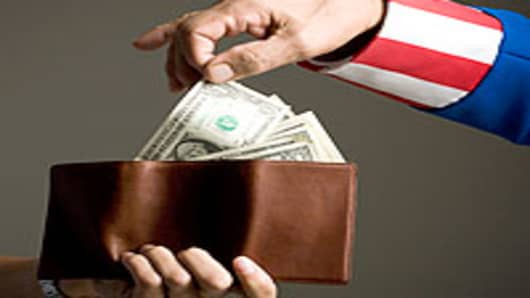Second quarter GDP Friday could be a game changer for markets that are anxious for any clues as to the depth and duration of the current soft patch.
While backward looking, second quarter GDP forecasts were cut dramatically as the June 30 quarter progressed, and economic data deteriorated. It is now expected to show 1.4 percent growth, down from 1.9 percent in the first quarter. The 8:30 a.m. ET report, which includes revisions back to 2009, will also influence the Fed’s discussions when it holds its two-day meeting next week.
“The previous quarter’s GDP print is very important because it’s the foundation on which you build your forecast going forward — what is in the mix in growth, what is In the mix in final demand and inventories,” said Deutsche Bank chief U.S. economist Joseph LaVorgna. He expects the second quarter grew by just 1 percent, but he is a bit more bullish than some economists for the second half and sees growth of 2.7 percent of the third quarter and 2.8 percent for the fourth.
“I think if you have a really lousy number, the Fed’s going to say, ‘you know we’ve been missing here for a while,’ and that could color their decision on whether to act aggressively or not,” said Michael Feroli, J.P. Morgan economist. “Whereas, if it comes in better, maybe they say: ‘Things aren’t quite as bad as we think.’”
While Fed watchers mostly do not expect the Fed to act next week, Feroli said the FOMC could do something like tweak the time frame for how long it anticipates keeping rates at extreme lows. “We think they extend the guidance from late 2014 to mid-2015,” he said.
The idea that the Fed will do more asset purchases, or quantitative easing, has been supporting stock prices. QE in the next round could be used by the Fed to buy mortgage securities, instead of the Treasurys it has previously bought. “I don’t think it’s inconceivable that they could start another round of QE, but I still think it’s more likely they do it in September rather than they do it next week. I think it’s going to be very dependent on what the next few jobs reports look like,” said Feroli. He said the weekly jobless claims report Thursday of 353,000 was a positive sign but too early to see as a trend.
The bumps hit by the economy in the second quarter have been showing up in corporate earnings reports, with the majority of companies missing on the top line and some on the bottom line. Amazon.com and Starbucks were the latest examples of companies with disappointing reports, after Thursday’s closing bell.
Facebook stock also got knocked to a new low in late trading, after the fledgling company showed in its first results as a public company that its capital expenditures were rising and its margins were declining. The company’s earnings met expectations, but It also saw its sizzling growth rate continue to slow. Other social media stocks, LinkedIn , Zynga and Groupon continued to decline after the closing bell.
Stocks soared Thursday on soothing comments from European Central Bank President Mario Draghi, who said the ECB would not allow the euro zone to fail and the central bank would do whatever it takes. The euro jumped 1 percent against the dollar, and Treasury yields firmed. Yields had hit new lows on fears about Europe earlier in the week, as Spanish and Italian bonds yields shot higher.
The Dow was up 211 points, or 1.7 percent at 12,887, and the S&P 500 rose 22 points, or 1.7 percent to 1360 Thursday. The gains were led by the defensive telecom sector, up 3 percent. Energy stocks, rising with oil prices, were second best, up 2.7 percent.
Stuart Freeman, head of equities strategy at Wells Fargo Advisors, said if the GDP number misses the market’s expectations Friday, stocks could head back toward the lower end of their recent range.
“Everyone’s thought about a lot of things that could or might happen. The market comes off, then it rallies again on good news, and we go through the whole cycle again. It goes back down on bad news we’ve already thought about , then it rallies on good news. We’re stuck in this range on news,” he said. Freeman says it will take until later in the year for the market to work through some of its issues, like Europe, the ‘fiscal cliff’ and Chinese growth concerns.
LaVorgna points out that the GDP number could be very important for markets, as it was last year. A year ago, the consensus for GDP in Q2, 2011 was 1.8 percent, but it came in at 1.3 percent, and on top of that there was a sharp downward revision to 2011 Q1 growth from 1.9 percent to 0.4 percent. There were also downward revisions to the second half of 2010.
“You add three quarters in a row of downward momentum and everything that was happening last year with the debt ceiling and Europe, that caused investors to worry about the U.S. economy. That was even worse than what’s happening now,” LaVorgna said. He said that soured sentiment but the economy ended up surprising in the second half of the year.
“I hope it’s a non-event,” he said of Friday’s number.
In addition to GDP, there is consumer sentiment at 9:55 a.m. Earnings reports are expected from Barclays, Merck, KKR, FEMSA, Weyerhaeuser, Newmont Mining, Calpine, DR Horton, Legg Mason and Chevron.
Follow Patti Domm on Twitter: @pattidomm
Questions? Comments? Email us at marketinsider@cnbc.com



